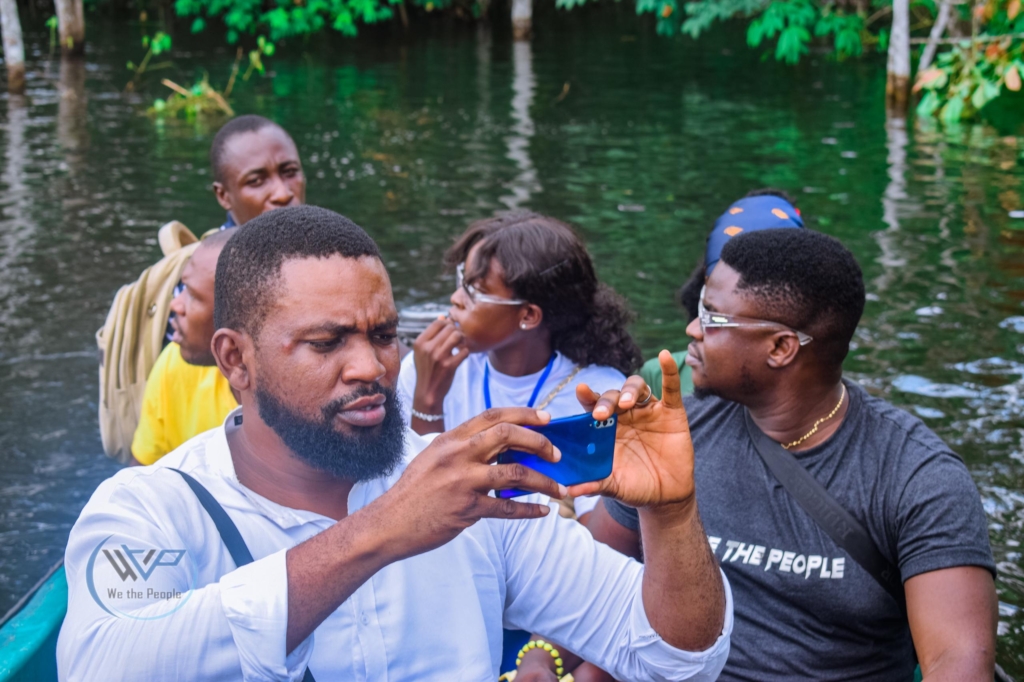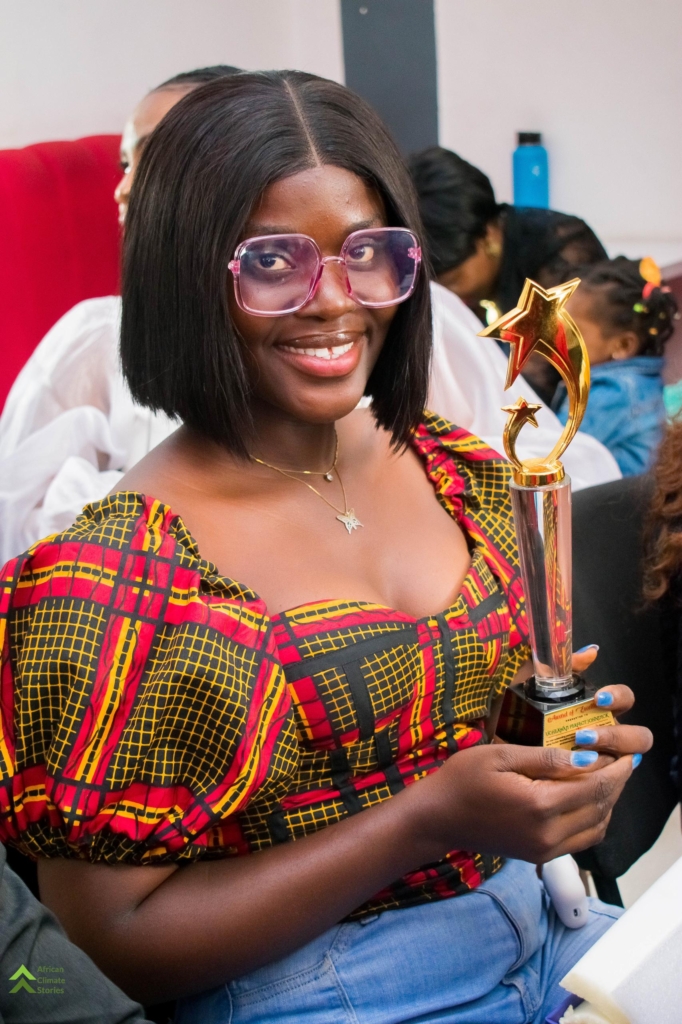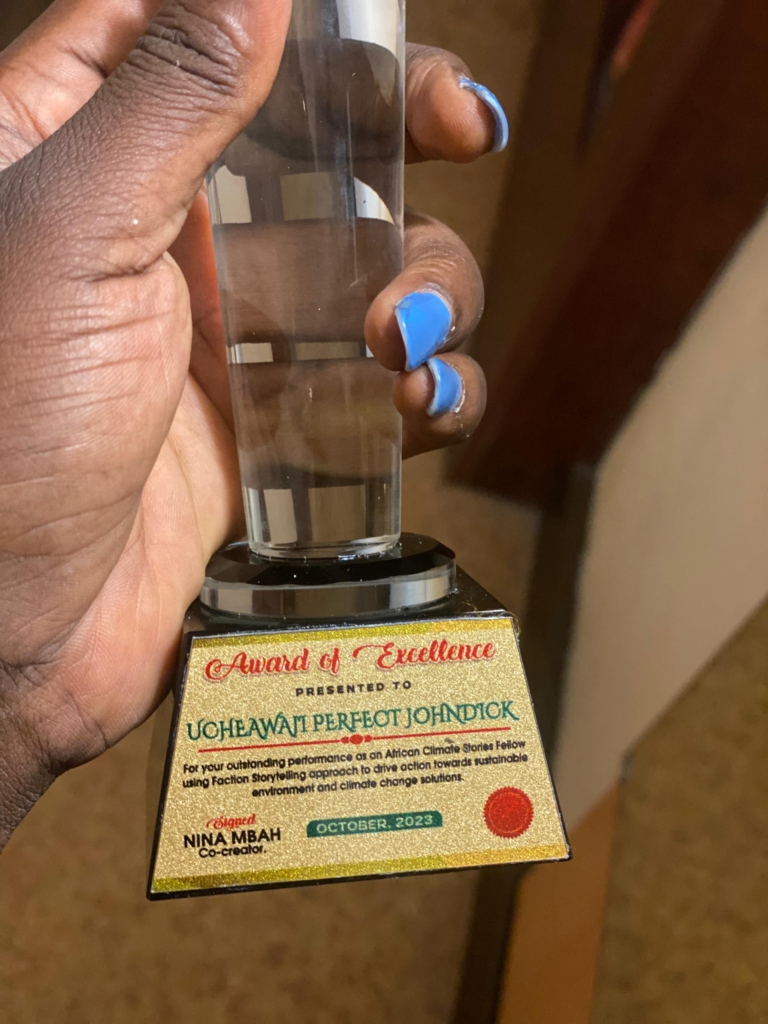This month, African Climate Stories features Perfect Johndick Uchawaji, a climate activist, an environmental advocacy content creator, and a 2023 African Climate Stories Fellow. Let’s dive into the inspiring story of this young Nigerian woman who has consistently been a voice to the Niger Delta’s Environmental state.
What personal experiences sparked your passion for climate activism?
As a child, I experienced firsthand the impacts of climate change and environmental hazards ranging from sea level rise, oil pollution, gas flares, polluted waterways, and more. Being the daughter of a clergyman and having to go from one missionary journey to the next in Rivers State, Nigeria, I realized that the issues in the Niger Delta are interconnected, heart wrenching, and profound. Oil spills and gas flares were fixed features in every community we served, and although I thought they were mere eyesores, I started understanding how they have affected standards of living, health, livelihoods, and the environment as I grew up. An example is seeing how fishes were swimming in oil-infested waters and how the sea level rose to our threshold on one of the missions.
When my brother was diagnosed with asthma because of the constant inhalation of gas flare fumes, I became interested in the campaign against extraction and environmental protection to create awareness of the secret enemy so that more people would not be victims. I have volunteered with three initiatives and presently work with We the People, an NGO in the Niger Delta that engages communities, stakeholders, and policymakers in the fight against climate change, nature commodification, and environmental hazards.

Being the daughter of a clergyman and having to go from one missionary journey to the next in Rivers State, Nigeria, I realized that the issues in the Niger Delta are interconnected, heart wrenching, and profound. Oil spills and gas flares were fixed features in every community we served, and although I thought they were mere eyesores, I started understanding how they have affected standards of living, health, livelihoods, and the environment as I grew up.
Perfect Johndick
CLIMATE ACTIVIST AND CONTENT CREATOR
How do you believe storytelling has effectively communicated the urgency of climate change and environmental degradation in your community?
I call myself an Artivist realizing that a lot of people are triggered to take action and stand as gatekeepers through storytelling with any form of art. Personal stories from individuals who have directly experienced the impacts of climate change make the issue relatable and urgent. These stories humanize abstract data and statistics, making the consequences of climate change more tangible and inspiring people to take action.
Can you share a specific moment where advocacy efforts that you have been a part of sparked action for climate justice due to speaking out with your stories?
Working with the Centre for Social Studies and Development (We the People), there have been many instances where we got our stories in the broader media, triggering actions for climate justice. My organisation tells stories of communities living with the harsh realities of climate change impacts, and my role in taking pictures and videos is to tell compelling stories. One of the specific moments where we sparked action was our report titled “Nowhere to Go.” This report tells the story of the harsh living conditions of displaced people, especially women and children, during the flood of 2022. Civil societies rallied around the report as they visited the communities and pushed for more campaigns, workshops, and stakeholder meetings against climate change and how to adapt to the changing living conditions.
What storytelling techniques do you find most impactful in engaging your audience on climate issues?
Documentaries and short explainer videos with B-rolls of footage. People tend to believe what they see more than what is written, so even when I want to tell climate stories in a poem, I try to make it visual for more empathy, reactions, and action.
How do you balance conveying the severity of climate change with inspiring hope and action in your stories?
After telling heartbreaking stories of the harsh realities of climate change impacts, I always emphasize the need to build resilience. My audience always sees the hope factor when I talk about the need to adapt in the face of a changing climate. Also, the call to action gives the audience the belief that the issues can be curbed, therefore leaving them with hope for the future.
What advice do you have for others looking to use storytelling as a tool for climate advocacy?
I will like to say, for starters, let the stories come from the lived realities of people. If you want to use storytelling as a tool for climate advocacy, it involves knowing your audience, platform and tailoring your narrative to resonate with their concerns and values, making personal stories central to humanize the issue. Balance the urgency of climate change with hope by highlighting solutions and positive outcomes, and enhance your message with visuals and multimedia. Connect global issues to local impacts and actions to make them more immediate, and leverage emotion and empathy to deepen engagement. I try to ensure I end with a clear call to action, and incorporate diverse voices to reflect the universal nature of the crisis, to maintain authenticity.
Have there been any significant attention, recognition, or support that you have gotten for telling your environmental stories?
I will start with my most recent award and the support I got from the African Climate Stories Fellowship in October 2023. After a three-month fellowship program on how to tell climate stories, I received an award for my outstanding performance using a faction to drive climate action towards a more sustainable environment and climate change solutions. But the first award I got from telling climate stories was in 2021 from the ‘Health of Mother Earth Foundation’, where I won the first prize for the best article from a learning session called “Learning from the Wise.” I also got the online United Nations Green Award for my climate advocacy.
What role do diverse voices and perspectives play in effective climate storytelling?
Personally, I believe that diverse voices and perspectives in climate storytelling are crucial for ensuring inclusivity, building trust, uncovering innovative solutions, engaging broader audiences, highlighting inequalities, sharing adaptation strategies, and fostering empathy—all of which ultimately drive meaningful action against climate change. It is also effective to connect global and local experiences
What advice do you have for young people who want to venture into environmental and climate change storytelling?
My involvement with activism generally began during my university undergraduate years, where I started to volunteer with organizations to address human and environmental rights. So I would say, start from where you are by volunteering to understand your skills and strengths to know how to leverage them. But also, while you can emulate other people, do not copy them; stories should be told as naturally as possible. Secondly, look for innovative ways to bring your stories to the public. Finally, be consistent; this will help build more trust and amplify your stories to a broader audience. Thank you!

To connect with Perfect Johndick use this link
Use this link to share your story with us to be featured as our next Climate Storyteller of the month https://forms.gle/k63zFBsaTTAydfMQA






